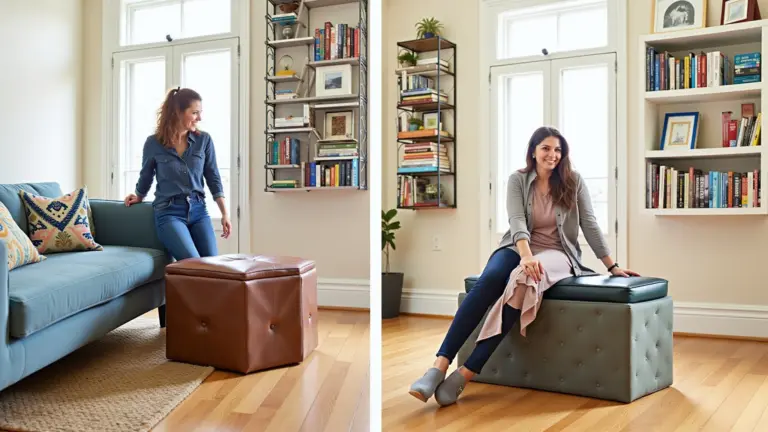Maximize Your Small Living Room: 15 Clever Ideas for a Spacious Feel
Maximize Your Small Living Room: 15 Clever Ideas for a Spacious Feel
Cramped living room got you down? Many of us face the challenge of a small living space. This post offers fifteen clever ideas to create the illusion of more room, transforming your cozy space into a comfortable haven.
Let’s be real, a small living room doesn’t have to feel claustrophobic. With a few strategic adjustments, you can make it feel bigger and brighter than you ever thought possible. I’ve lived in my share of small apartments, so I’ve learned a thing or two about maximizing space. Let’s dive in!
What is Maximizing Space in a Small Living Room?
Maximizing space means using design tricks and clever furniture choices to make your small living room feel larger than its square footage suggests. It’s about creating an open, airy atmosphere, not about cramming in more furniture.
1. Lighten Up: The Power of Paint Color
You know what instantly brightens a room? Light colors! Opt for lighter shades on your walls—think soft whites, creamy pastels, or light grays. Dark colors absorb light, making a room feel smaller. Light colors, however, reflect light, creating the illusion of more space. Consider a soft, warm white to give your living room a fresh, airy feel.
2. Mirrors, Mirrors on the Wall…
Mirrors are your best friend in a small space. Strategically placed mirrors can double the perceived size of a room. Position a large mirror opposite a window to reflect natural light and create depth. A few smaller mirrors can also add visual interest and make the room feel more open.
3. Multifunctional Furniture: Your Secret Weapon
Well, this is key! Multifunctional furniture is essential for maximizing space. Consider an ottoman with storage, a sofa bed, or a coffee table that lifts to reveal storage. These pieces save space while providing extra functionality. Think of it as getting two for the price of one!
4. Embrace Minimalism: Less is More
Less is definitely more when you’re dealing with limited space. Declutter ruthlessly! Remove anything that isn’t essential or visually appealing. Keep surfaces clear and organized. A minimalist approach will make your living room feel significantly more spacious and less cluttered.
5. Vertical Storage Solutions
Think upwards! Utilize vertical space with tall bookshelves or narrow cabinets. This keeps items off the floor and creates a sense of openness. Vertical storage is a game-changer for small spaces, so don’t underestimate it.
6. Strategic Furniture Placement: The Flow is Key
Arrange your furniture to maximize flow and create a sense of openness. Avoid blocking walkways or creating cramped corners. Leave enough space to move easily around the room. A good flow makes a small space feel much larger.
7. The Magic of Sheer Curtains
Heavy curtains can make a room feel smaller and darker. Instead, opt for sheer or lightweight curtains that allow natural light to filter through. This creates a brighter, airier feel, expanding the visual space. The right curtains make all the difference!
8. Rugs: Defining and Expanding Space
A well-chosen rug can anchor your furniture and create a sense of intimacy in a small living room. Choose a rug that’s large enough to accommodate your furniture but not so large that it overwhelms the space. A lighter-colored rug can help make the room feel larger.
9. Streamline Your Decor: Quality Over Quantity
When it comes to decor, choose quality over quantity. A few well-chosen pieces will have a greater impact than a lot of clutter. Focus on items that add personality and style without overwhelming the space. This helps create a more peaceful and spacious feel.
10. Maximize Natural Light: Open Those Windows!
Natural light is your friend! Keep windows unobstructed to allow as much natural light as possible to flood the room. This will instantly make the space feel brighter and more open. Let the sunshine in!
11. Clever Lighting: Layering is Key
Layering your lighting is crucial. Combine ambient lighting (overhead lights), task lighting (lamps), and accent lighting (decorative lights) to create a warm and inviting atmosphere. Avoid harsh overhead lighting, which can make a small room feel smaller.
12. Choose the Right Furniture Scale
Avoid oversized furniture. Select pieces that are appropriately sized for your living room. Oversized furniture can make a small space feel cramped and overwhelming. You want furniture that fits the room, not the other way around.
13. Embrace a Consistent Style
A unified style can make a small living room feel more spacious. Choose a cohesive color palette and style for your furniture and decor. This creates a sense of harmony and avoids visual clutter.
14. Think About Texture and Pattern
Introduce texture and pattern strategically. A textured throw blanket or a patterned rug can add visual interest without overwhelming the space. However, avoid using too many patterns or textures, which can make the room feel busy.
15. Personal Touches: Make it Yours
Finally, add personal touches that reflect your personality and style. This will make your living room feel more comfortable and inviting. Remember, a small living room can still be stylish and personalized. Don’t be afraid to inject your own unique flair.
My Personal Tip: The Unexpected Power of a Gallery Wall
Something I discovered through trial and error is the power of a well-curated gallery wall. Instead of a few large pieces of art, I created a gallery wall with smaller framed prints and photographs. This visually expanded the space and added a ton of personality without feeling overwhelming. It’s a fantastic way to add character without sacrificing space.
Frequently Asked Questions
How can I make my small living room feel bigger without spending a lot of money?
Focus on decluttering, rearranging furniture, and maximizing natural light. These are simple, cost-effective ways to make a big difference.
What are the best colors to paint a small living room?
Light and neutral colors like soft whites, pastels, and light grays reflect light and make a room feel larger. Avoid dark colors, which absorb light.
What kind of furniture is best for a small living room?
Multifunctional furniture, such as ottomans with storage or sofa beds, is ideal for small spaces. Choose pieces that are appropriately sized for the room.
How can I add storage to my small living room?
Utilize vertical space with tall bookshelves or narrow cabinets. Consider ottomans with storage or coffee tables with hidden compartments.
What are some simple ways to improve the lighting in my small living room?
Maximize natural light by keeping windows unobstructed. Layer your lighting using ambient, task, and accent lighting to create a warm, inviting atmosphere.
Can I use rugs in a small living room?
Yes, but choose a rug that’s large enough to anchor your furniture but not so large that it overwhelms the space. A lighter-colored rug can help make the room feel larger.
One last thing to remember:
Don’t be afraid to experiment! Try different arrangements, colors, and decor until you find what works best for your space and your style. Your small living room can be both stylish and functional—it’s all about creative solutions and a little bit of ingenuity.



